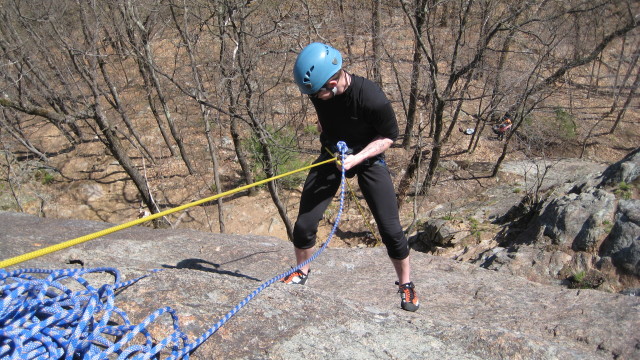If you’ve never done it before, rock climbing might not be the first activity that comes to mind when you plan a mountain getaway, but it should be! Rock climbing is a unique way to enjoy the mountains and challenge yourself. After I tried it for the first time during a spring weekend in the Mount Washington Valley, I was hooked!
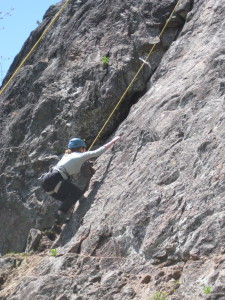
Before I gave it a fair shot, I didn’t think I was cut out to be a rock climber. My arms have been compared to hotdogs and I had a fear of heights that had remained untested on purpose. And after one childhood experience with the Girl Scouts that combined an indoor climbing gym with an overzealous scout mother, I swore off rock climbing, I thought, forever.
Based on that early fiasco, I would have stuck out my chin and told you that I didn’t like rock climbing, I wasn’t good at it, and I wasn’t going to do it. But a few friends pushed me to try it again during a sunny weekend in northern New Hampshire. So I gave rock climbing another chance, and found out that it’s about more than getting up a rock. It requires team support, mental effort, and courage.
My complete change of heart occurred in the middle of a rock climbing lesson with the International Mountain Climbing School (IMCS) based in North Conway. As I “hung out” on my safety rope, 40 feet above the ground about halfway up the route called “Cakewalk” on Humphrey’s Ledge in North Conway, looking over what seemed like most of New Hampshire, I was having fun, and darn proud of myself for getting up there!
A professional rock climbing lesson was the only way I was going to give a sport like rock climbing, which is outside of my normal activity range, any possibility of a chance. If you’ve ever been accused of having “hotdog arms” and just don’t know where to get started, a rock climbing lesson is probably what you’re looking for!
My friend sam and I showed up for our lesson on a sunny Saturday morning at the world headquarters of IMCS. The school is less intimidating than the name implies, though the gear they sell in the downstairs shop, International Mountain Equipment, might just have you thinking about taking on Mount Everest (as one of the school’s current owners, Rick Wilcox, did in 1994).
The school has been teaching the trade of scaling rock and ice in the White Mountains for more than 30 years. Their American Mountain Guides Association-certified instructors take students up popular climbing locations like Cathedral and Whitehorse Ledge, the Frankenstein Cliffs (nothing scary about THAT name!), and Cannon Cliff. Time your lesson right, and they’ll even instruct you in how to scale ice flows!
The prospect of an adventure like that had me daydreaming, but others in the class brought me back to earth and reminded me that learning to climb is all about baby steps. First, I needed to learn how to put on a harness.
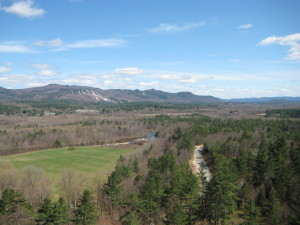
We met our instructor, Zeb Jakub, who taught us this first, all-important step. He also got us ready to go with helmets and shoes that looked a little and felt a lot like ballerina slippers. (But don’t worry, boys, they’re black and don’t have any ribbons.) The soles of the shoes, Zeb told us, are made of some of the softest and stickiest rubber that can possibly be put on a shoe. They are designed to create friction and grip rock.
As it turned out, much of rock climbing is about “design” and brainpower. I’m pretty sure the first rock climbers must have been physics geeks who became athletes, or maybe it was the other way around. The engineering that’s gone into the climbing equipment and techniques (knots, harnesses, ropes, etc.) was beyond me.
Fortunately, Zeb understood perfectly well how it all worked. He talked us through everything, including why a quarter-inch shoestring-looking thing (Zeb called it by it’s technical name, a “rope”) would hold all of your body weight when it came time to dangle high in the air off a BIG rock.
Not being much for physics, I stared blankly as Zeb explained why the gear worked. Even though I didn’t completely get it, I felt confident knowing that he understood it. No amount of physics knowledge can beat experience, though, and Zeb had plenty of that. He began climbing as a little kid and started working with IMCS in 2000. I had complete confidence in Zeb’s background and knowledge of this sport he obviously loved so much.
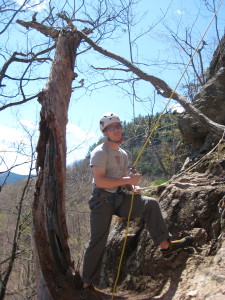
Trust in your instructor, the person who will keep you safe, is important. If it’s your first time and you’re feeling nervous, ask your instructor questions and get to know him or her. Listening to Zeb made me feel better about the challenges to come and made me a more confident climber right away. The entire experience is simpler, a lot more fun, and much safer when learning with a professional instructor.
Because I had confidence in Zeb, I had confidence in myself. Harnessed in and “on belay,” you have to believe that your body can push and pull you up to that ledge that seems so impossibly steep. You can make that reach without any legitimate fear when you know a great team has got your back. The adrenaline rush is unbeatable, and you find out that you’re stronger than you thought you were.
As it turns out, my so-called “hotdog arms” can do more than any hotdog I’ve ever encountered. I’ll bet you’re stronger than you realize too, but you’ll never know if you don’t try!
Rock climbing isn’t all about brawn though. It also requires some noodle work. Before Sam and I began our first climb up a stretch called Cakewalk, Zeb warned us that it’s easy to see just one way up, explaining that route might not be the best when you’re tired or panicked. You must consider all of the options and focus on remaining calm despite any fear of falling (which, thanks to the safety rope, isn’t even really falling). Figuring out the optimal route up is a bit like putting together a puzzle.
But unlike a puzzle, there’s no “right answer.” Because every climber’s strengths are different, there are often as many routes as there are climbers. Sam, who’s taller and stronger than I am, took a route suited to his strengths. I’m smaller and more flexible, and successfully negotiated a different route to the same goal.
Once you begin climbing, you’re on your own. But Zeb will explain a helpful technique if someone becomes stuck. For example, he taught me that it’s often useful to wedge your feet between two vertical protrusions and climb up as you would between two narrow walls.
Feeling like Catwoman as I attempted these maneuvers, I finally made it to the top of Cakewalk. If the climbing itself was fun, reaching the top and looking out over the White Mountains was the icing on the Cakewalk (with real flowers instead of the kind made of frosting).
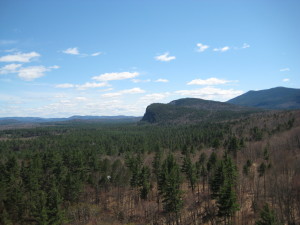
The spring was taking over after the long winter, and I put my camera in peril trying to take a shot that would capture the mountains’ beauty. Although the pictures from up top were lovely, they don’t quite capture the actual scene that lay below us. Guess you’ll have to climb up to see it for yourself!
I could have hung off of the anchor at the top of Cakewalk for hours, but that wasn’t exactly practical, so down we went. Zeb taught us how to rappel back to the ground, and I hummed The Who’s “I Can See For Miles” as I skipped down the rock.
The rappelling was scary at first because you don’t have an instructor at the bottom to release rope for you. You control the speed at which you descend all by yourself. However,once we got the hang of it, Sam and I both decided that it was an easy process, and we liked the freedom. Zeb said most people feel the same way. Being in control and doing it yourself is thrilling.
“Doing it yourself” is what rock climbing is all about and what makes it so fun. You figure out your route, you push and pull yourself to the top, and you feel the accomplishment of your climb. But, it’s still a shared victory with the rest of the team.
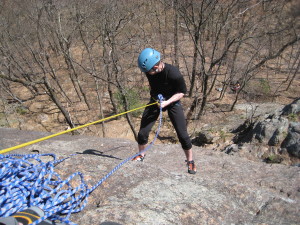
Back on the ground, I felt a little wobbly and unsafe as I took off my safety harness. As a generally clumsy person prone to tripping over sidewalk cracks, I’m thinking I should wear a safety harness and helmet permanently. Especially since I’ll be climbing more now that I’ve gotten a taste for this fun sport.
I’ve even convinced a friend who’s never climbed to come learn with me. I’m sure he’ll enjoy it, and so would you. So meet up with a climbing instructor, tie into a harness, and get hooked on rock climbing!


